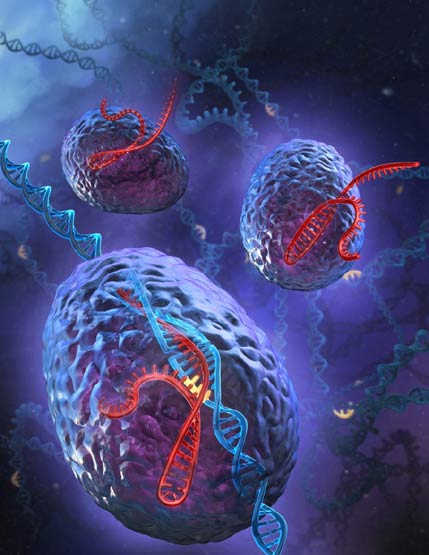 A 3D artist's rendering of the powerful genome editing tool, CRISPR/Cas9.
A 3D artist's rendering of the powerful genome editing tool, CRISPR/Cas9.Photo by: Stephen Dixon --- Special to The Washington Post
WASHINGTON --- Don't look now, but the future just pulled into town.
Hundreds of scientists, policymakers and the president's science adviser have gathered Tuesday in Washington for a three-day summit on genetic engineering, with a focus on a new, relatively simple technique for manipulating genes. It's fast and flexible, and just about anybody with some lab equipment and a little know-how could alter the human species. The technique is called CRISPR-Cas9, or simply CRISPR, and more generically referred to as "gene editing."
The summit kicked off early Tuesday morning at the headquarters of the National Academy of Sciences, which is one of the sponsors, along with the National Academy of Medicine, the Royal Academy (U.K.), and the Chinese Academy of Sciences. The Chinese scientists have been aggressive in using CRISPR, and one team made news earlier this year when it reported results from experiments on nonviable human embryos.
"The overriding question is when, if ever, we will want to use gene editing to change human inheritance," summit chair David Baltimore of Caltech said in his introductory remarks.
Another question, he said, is whether and when this technique should be used for "human enhancement." Such genetic changes would potentially be for cosmetic or competitive advantages -- not merely a therapies for medical conditions.
"These are deep and disturbing questions that we hope will be illuminated by this meeting," Baltimore said.
The reason CRISPR is so controversial is that it works well on "germline" cells, such as sperm, eggs and embryonic cells, and the genetic editing results in heritable traits. Many scientific organizations have called for a time-out on any experiments on human cells, fearing that this crosses into dicey ethical territory. This meeting in Washington could generate a new call for restraint, or some guidelines in how to handle the explosive technology. Baltimore said he hopes that the final session on Thursday will include recommendations for a path forward.
The gathering has an obvious analog to the famous Asilomar conference of 1975. That gathering on the Monterey Peninsula was called after scientists realized they could use splice DNA from one organism into another, and that this raised an "Island of Dr. Moreau" scenario that could lead to hybrid organisms and potentially pose all sorts of environmental risks. The Asilomar conference produced a set of protocols meant to lower those risks and allow the research to continue.
Now comes CRISPR. As The Washington Post reported earlier this year, the technique borrows a move from bacteria. In a bacterium's DNA are segments of genetic information that bear the likeness of viral pathogens, kind of like the FBI's Most Wanted bulletins at the post office. The bacterium has an enzyme, called Cas9, that can read that likeness, scout the environment for anything looking the same, and then, when finding a likely suspect, snip lengthwise the entwined double-helix DNA strands of the invader.
The CRISPR technique uses the Cas9 enzyme as a gene-snipper. If properly targeted it can precisely edit genes. Getting to a high level of precision has been tricky to date, but the experimentalists have made great strides in just the few years since the idea of using the enzyme for gene editing emerged from laboratories in Massachusetts and California (who, exactly, discovered the CRISPR technique and deserves the patents for it is a matter of intense legal wrangling).
Tuesday morning, even as the scientists gathered at the National Academy, news broke from the journal Science that researchers at the Broad Institute, Harvard University and M.I.T. have come up with a new way to use CRISPR that reduces the potential for off-target gene-snipping. This promises to enhance the efficiency of the gene-editing tool. Among the authors of the new paper is one of the pioneers of the CRISPR technique, Feng Zhang -- who is here for the summit. "Human intention is entering matter," the futurist Barbara Marx Hubbard told The Washington Post way back in 1998. "It means that instead of evolution working by natural and unconscious selection, evolution is beginning to happen through conscious choice." Hubbard was not at all worried about this, because she envisioned the human species spreading through outer space, becoming galactic and ultimately a cosmic intelligence.
"Human intention is entering matter," the futurist Barbara Marx Hubbard told The Washington Post way back in 1998. "It means that instead of evolution working by natural and unconscious selection, evolution is beginning to happen through conscious choice." Hubbard was not at all worried about this, because she envisioned the human species spreading through outer space, becoming galactic and ultimately a cosmic intelligence.
But in the meantime, we've got some decisions to make. There's nothing much at stake except human destiny.


 Contact The Editor
Contact The Editor
 Articles By This Author
Articles By This Author
